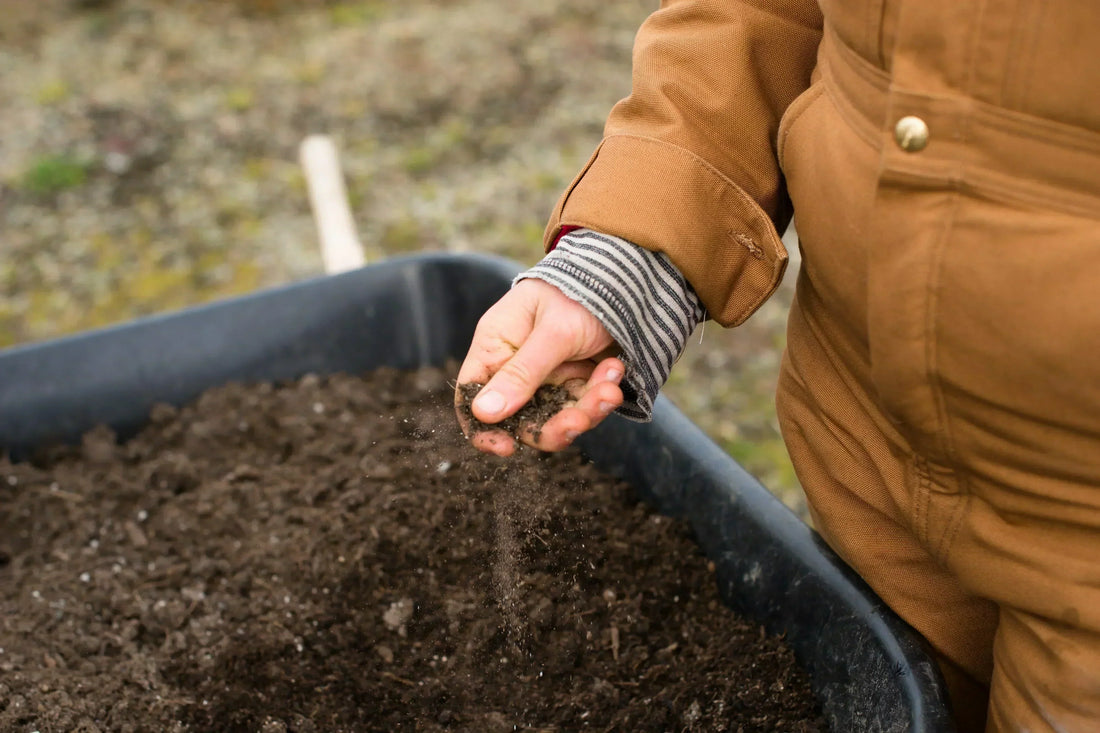
Best Organic Fertilizer for Plants: Full Comparison of Frass, Manure & Chemical Options
Share
Fertilisers are the key to growing large and healthy plants. There are two categories: chemical and organic fertilisers. Chemical fertilisers are man-made mixes of the main nutrients needed for plant development. Organic fertilisers are natural by-products of farming, like manure or composted plant waste, containing nutrients and beneficial microorganisms.
Chicken manure is one of the most popular organic fertilisers, but an emerging organic fertiliser is the waste product of insect farming. Frass contains all the nutrients plants need, plus an extra compound, chitin, that activates plant defence systems and increases resilience.
At The Bug Factory, we’ve worked extensively with insect frass and have seen firsthand how it improves soil structure, reduces pests, and supports resilient plant growth even in small garden setups.
So, which one should you pick? This article compares all
1. Nutrient Composition of Organic vs Chemical Fertilizer
Experts recommend testing your soil first to understand its nutrient profile. That way, you avoid over-fertilising and causing fertiliser burn. All fertilisers are sold with the composition of nitrogen (N), phosphorus (P), and potassium (K), the NPK. Manufacturers can make chemical fertilisers to any NPK ratio, though an equal mix of all three is commonly used.
The NPK of organic fertilisers depends on the animal’s feed. Chicken manure usually has an NPK ratio of 4-3-2 or 4.5-3.5-2.5. Insect frass varies more (depending on the insect and feed), with studies showing mealworm frass can have nitrogen content ranging from 2.6% to 7.6%. Commercial frass fertiliser is often sold as 2-2-2, 3-1-1, or 3-2-4.
2. How Different Fertilizers Affect Plant Types and Growth
Plants that produce fruit should receive fertilisers high in phosphorus and potassium, as nitrogen primarily supports leaf growth. Commercial tomato fertiliser often contains high potassium levels. Root vegetables like potatoes and onions benefit from higher phosphorus and potassium levels. For leafy vegetables such as lettuce or sprouts, a balanced or high-nitrogen fertiliser works well.
Perennial flowers are more sensitive and can be damaged by over-fertilisation, so avoid liquid chemical fertilisers. Unless grown in infertile soil, only some flowers (called ‘heavy-feeders’) need fertiliser. These include chrysanthemums, lupines, lilies, and peonies. These flowers respond well to fertilisers high in phosphorus and nitrogen. Bushes and trees, especially young ones, also benefit from fertilisers with higher nitrogen content.
3. Cost Comparison: Chemical Fertilizer vs Chicken Manure vs Insect Frass
In the United States, synthetic chemical fertilizers typically cost between $1.25 and 6.25 per kilogram (approximately £1–5). Although once more affordable, prices have surged in recent years, rising more than 30% since early 2022. In many developing regions, high costs still limit accessibility and crop productivity.
Chicken manure fertilizer is a more budget-friendly organic option, priced around $1.25–2.50 per kg (£1–2). It’s widely available in bagged or pellet form for home gardeners.
Insect frass fertilizer, while newer and less common, is gaining popularity for its added plant health benefits. It currently costs about $4–10 per kilogram (£3–8) in the US. DIY production through home insect farming can significantly reduce the cost.
Learn more about how our Mealworm Growing Pods make it easy to produce your insect frass at home.
4. Nutrient Release Speed: Organic Fertilizers vs Synthetic Fertilizers
Synthetic fertilisers contain pure chemical nutrients, so plants absorb them quickly. These fertilisers don’t require breakdown in the soil. Some products are made to release slowly, while others, like liquid fertilisers, act even faster.
While certain plants prefer a steady release of nutrients over time, fast-growing or nutrient-demanding plants may not get enough nitrogen from slow-acting fertilisers. In such cases, chemical fertilisers may be more effective.
5. Environmental Impact of Organic and Chemical Fertilizers
The environmental impact of producing chemical fertilisers is significant. The Haber-Bosch process, which creates ammonia, contributes around 1.4% of global carbon emissions and consumes 1% of the global energy supply. Mining potassium and phosphorus damages habitats, pollutes water with heavy metals, and lowers air quality.
Overusing fertilisers also harms soil health in the long term by depleting organic material, removing essential minerals, and increasing soil acidity. Chemical nutrients can run off into water sources, creating ‘dead zones’ that deplete oxygen and kill aquatic life.
Although less impactful, chicken farming still affects the environment. Soybean production for animal feed drives deforestation due to rising global meat demand. Chicken supply chains also release around 0.6 gigatonnes of CO2-equivalent about 8% of livestock-related emissions.
Manure fertiliser can also carry infectious bacteria that linger on crops and enter the food chain. Pesticides and herbicides can pass through the animal food chain into manure, reducing crop yields when applied to soil.
Insect farming has a much smaller environmental impact due to its lower scale. Insects produce about half as much CO2 as chickens and nearly ten times less than cows. Using food waste to feed insects creates a sustainable, circular process, transforming low-value inputs into high-quality organic fertiliser.
6. Pest Resistance Benefits of Insect Frass Fertilizer
As you may know, farmers apply chemical pesticides to protect crops from pests. However, these chemicals can remain in the soil for years and may enter the food chain. What if the fertiliser itself could boost crop resistance to pests? Insect frass does exactly that.
Frass contains chitin, a molecule found in insect skin and other exoskeletons. Chitin acts as a ‘microbe-associated molecular pattern’, meaning plants mistake it for a microbe and activate their defences.
Research shows that pure chitin prevents parasitic root-knot nematode worms just as effectively as the banned pesticide oxamyl. Indian researchers found that peanut plants treated with chitin yielded more and had fewer nematodes. Chitin also enhances microbial activity in the soil, functioning differently from traditional pesticides.
In one patent study, wireworms killed 90% of lettuce plants that didn’t receive frass. Meanwhile, plants treated with frass remained healthy.
7. Disease Resistance Properties of Organic Fertilizers with Chitin
Chitin also helps plants resist disease. It reduces lesions on cabbage and strawberry plants. It also promotes lettuce growth and suppresses pathogens that can infect humans. Chitin prevents root-rot in radishes and activates microorganisms that produce natural antibiotics.
In one study, after a wilt infection hit a cowpea field, untreated plants died, but those treated with frass stayed healthy.
Comparison Table: Choosing the Best Organic Fertilizer for Plants
|
Feature |
Chemical Fertiliser |
Chicken Manure |
Insect Frass |
|
Cost (/kg) |
$1.25–6.25 (~£1–5) |
$1.25–2.50 (~£1–2) |
$4–10 (~£3–8) |
|
Application Types |
Pellets, Granules, Liquid |
Pellets, Powder |
Pellets, Powder |
|
Macronutrients |
Yes |
Yes |
Yes |
|
Micronutrients |
If specified |
Yes |
Yes |
|
Other Components |
None |
Microorganisms |
Microorganisms + Chitin |
|
Speed of Absorption |
Fast |
Slow |
Slow |
|
Environmental Impact (Production) |
High |
Medium |
Low |
|
Environmental Impact (Use) |
High |
Low |
Low |
*Chemical fertilisers can be NPK only.
Conclusion: Which Is the Best Fertilizer for Your Plants?
The comparison table above summarises the topics covered in this article.
Chemical fertilisers are versatile and can be tailored to any nutrient combination, making them suitable in many situations. However, they degrade soil health over time by stripping away organic material. Their production also causes significant pollution, with ammonia manufacturing alone estimated to account for 1.6% of global carbon emissions.
Chicken manure is inexpensive and supplies all essential nutrients. But because it’s an organic fertiliser, it needs to break down in the soil to release those nutrients, which may not meet the needs of nutrient-hungry plants. It may also carry harmful bacteria, and its production raises environmental and ethical concerns.
Insect frass is more expensive because it's a newer product. However, it boosts plant resilience to stress and disease, in addition to supplying essential nutrients and micronutrients. Like chicken manure, it’s organic and may not suit fast-absorbing, nutrient-demanding plants.
In short, chemical fertilisers work well for heavy-feeding plants like large fruiting vegetables. However, organic fertilisers are better for most other plants and long-term soil health. You can even combine both to balance performance with environmental sustainability.
Want to try frass in your garden? Explore our Mealworm Growing Pods to start producing your own high-quality insect frass fertilizer at home.
This article was written by The Bug Factory content team, in collaboration with horticulture and sustainability experts. We specialize in insect-based solutions that promote regenerative gardening and sustainable living.
